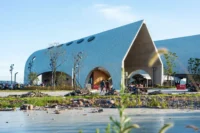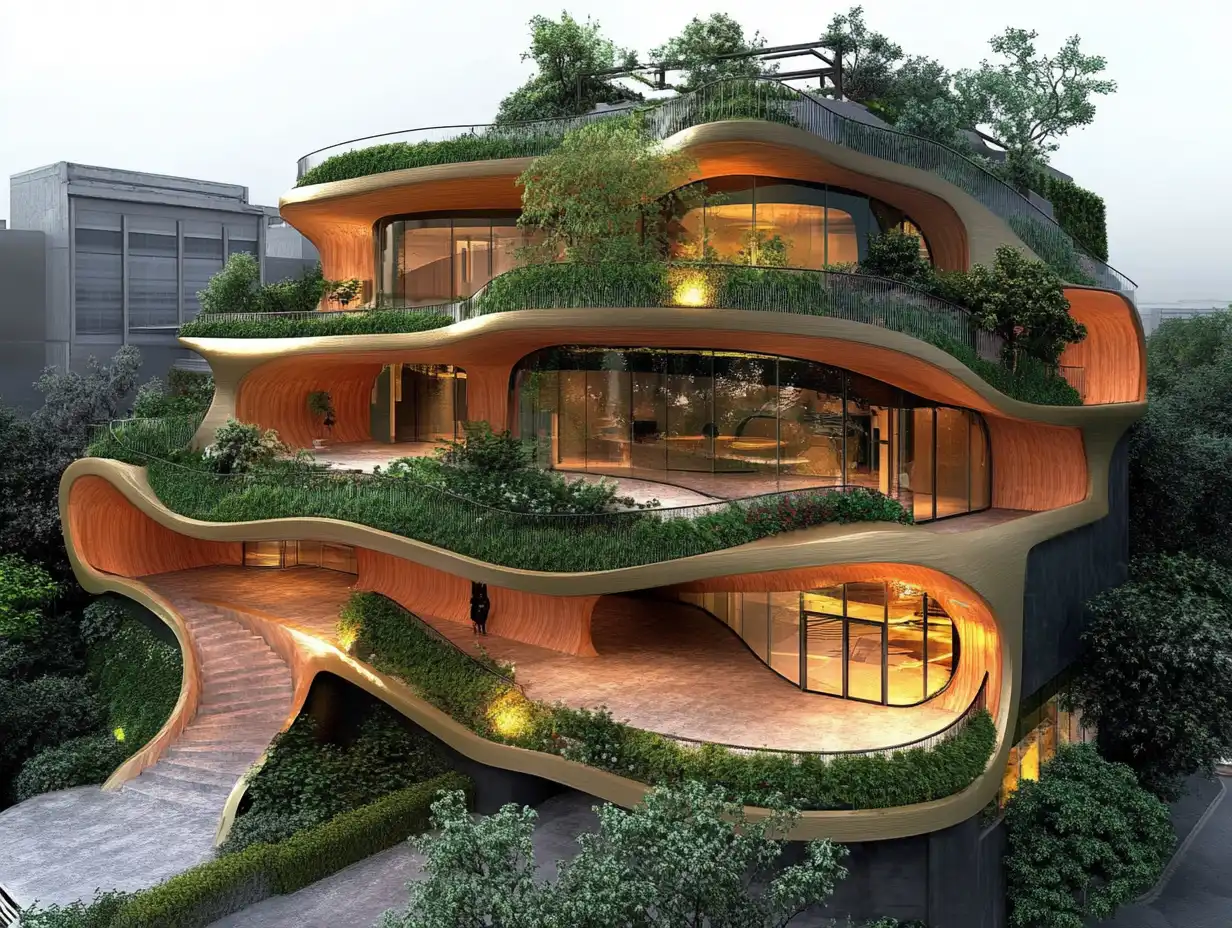When it comes to designing innovative and sustainable architecture, nature offers a treasure trove of inspiration. By exploring our natural surroundings, we can uncover unique forms, materials, and patterns that seamlessly blend beauty with functionality. This approach not only fosters creativity but also promotes eco-friendly practices that harmonize with the environment.
As we delve into the world of natural architecture, we’ll discover how elements like landscapes, flora, and fauna can influence our design concepts. By observing the intricate details and inherent efficiencies in nature, we can create structures that are not only aesthetically pleasing but also sustainable and resilient. Let’s embark on this journey to see how nature can redefine our architectural boundaries.

The Importance Of Natural Surroundings In Architecture
Natural surroundings play a crucial role in architecture by offering design inspiration and grounding buildings in their environment. We draw from the intrinsic beauty of landscapes to create structures that resonate with their surroundings. For instance, incorporating natural light, ventilation, and indigenous materials can make buildings more sustainable and energy-efficient.
Architects observe patterns in nature, such as fractals in foliage or the spiral of a shell, to develop unique and innovative designs. These organic patterns often lead to structures that are not only visually pleasing but also functional. Emulating the structural efficiency seen in natural forms can result in buildings that use fewer resources and stand up better to environmental stressors.
The integration of green spaces within architectural designs doesn’t just enhance aesthetic value; it also impacts the well-being of occupants. Research from the Environmental Health Perspectives journal indicates that access to nature can reduce stress, improve mood, and increase productivity. By embedding natural elements like rooftop gardens, living walls, and water features, we can create healthier and more enjoyable living and working spaces.
Natural surroundings influence our choice of materials, pushing us to use locally-sourced and sustainable options. This not only reduces the carbon footprint of construction but also supports local economies. Utilizing materials like bamboo, reclaimed wood, and stone ties the building to its geographic context, making it a true reflection of its environment.
Connecting our designs to natural surroundings also involves considering the site’s topography and climate. Each site offers unique challenges and opportunities, from harnessing natural light to optimizing thermal comfort. For example, architects in desert environments might design buildings with thick walls and small windows to maintain cool interiors, while architects in humid regions might prioritize ample ventilation to prevent mold growth.
By exploring and respecting natural surroundings, we create architectural concepts that are not only innovative and beautiful but also sustainable and harmonious with the environment.
Benefits Of Integrating Nature Into Design
Architectural design that integrates nature offers myriad benefits, enhancing health, sustainability, and overall functionality of structures.
Health And Well-being
Incorporating natural elements into architectural designs boosts occupant well-being. Natural light helps regulate circadian rhythms, improving sleep and mood. Access to green spaces lowers stress and enhances productivity, as studies in “The Lancet” show a 19% reduction in stress among individuals with daily exposure to nature. Indoor plants, natural ventilation, and views of nature provide mental health benefits, creating a more serene and healthier environment.
Sustainability
Building sustainability improves when nature is integrated into design. Natural materials like stone, wood, and bamboo reduce synthetic material use, decreasing carbon footprints. Designs that consider natural light and ventilation enhance energy efficiency, minimizing HVAC system reliance. Green roofs and walls contribute to rainwater management, reducing runoff and improving insulation. Local materials not only support regional industries but also cut transportation emissions. As per the US Green Building Council, structures using sustainable materials and practices can achieve up to a 30% increase in energy savings.

Techniques For Analyzing Natural Surroundings
Exploring natural surroundings offers invaluable insights for architectural concepts. Analyzing these elements involves distinct techniques to ensure designs honor the environment and optimize natural benefits.
Site Analysis
Analyzing a site involves collecting data on topography, soil types, and vegetation. We use topographic maps to understand elevation changes which guide building orientation and water management plans. Soil tests determine foundation stability, while vegetation studies reveal plant species that can be preserved or incorporated into landscaping. Documenting existing roads, pathways, and water bodies helps in integrating the architecture with minimal disruption to the natural landscape.
Environmental Impact Assessment
Assessment of environmental impact ensures sustainable architecture. We evaluate ecosystems to understand the potential disruption our projects might cause. By studying local wildlife habitats, we can plan structures that minimize ecological disturbance. Energy consumption assessments help in designing energy-efficient buildings, reducing carbon footprints. We also consider water usage, evaluating strategies for rainwater harvesting and greywater recycling. This holistic approach ensures our architectural concepts contribute positively to the environment.
Case Studies Of Nature-Inspired Architectural Concepts
Exploring nature can yield innovative architectural concepts. Let’s examine successful projects and the lessons learned from such endeavors.
Successful Projects
- Fallingwater, USA: Designed by Frank Lloyd Wright, this residence integrates seamlessly with its surroundings. Built over a waterfall, it uses local stone and expansive glass windows to blend with the landscape. The house exemplifies harmony between architecture and nature.
- Eden Project, UK: Located in Cornwall, this complex houses biomes filled with diverse plant species. The structures resemble inflated bubbles, mimicking nature’s efficiency. They utilize sustainable materials and natural ventilation, showcasing environmentally conscious design.
- Bosco Verticale, Italy: Milan’s vertical forest comprises two residential towers covered in trees and shrubs. The vegetation improves air quality and reduces energy consumption. This project demonstrates how urban spaces can incorporate greenery to benefit residents and the environment.
- Site Integration: Fallingwater taught us the importance of designing structures that complement their environments. Understanding natural elements like water and stone creates a cohesive design.
- Sustainability: The Eden Project highlights the potential of using nature-inspired forms and sustainable practices. Utilizing local materials and creating efficient structures can lead to eco-friendly solutions.
- Urban Greening: Bosco Verticale illustrates the advantages of vertical gardens in urban areas. Green facades not only enhance aesthetics but also contribute to environmental health and energy efficiency.
Examining these case studies, we see the profound impact nature can have on architectural design.

Tools And Resources For Architects
Architects must use a variety of tools and resources to effectively integrate natural surroundings into their designs. Advanced software and traditional methods both offer valuable insights and capabilities.
Software And Technology
- Building Information Modeling (BIM): BIM software, such as Autodesk Revit and ArchiCAD, enables us to create detailed 3D models that incorporate environmental factors like sunlight and wind patterns. This helps in simulating the impact of natural elements on the design.
- Geographic Information System (GIS): GIS tools offer spatial data analysis, allowing for precise environmental assessments. Platforms like Esri ArcGIS provide information on topography, vegetation, and hydrology crucial for site planning.
- Energy Modeling Software: Tools like EnergyPlus and Sefaira allow us to evaluate energy performance, optimizing designs for better sustainability by analyzing heating, cooling, and lighting requirements.
Traditional Methods
- Sketching and Hand Drawing: Despite the rise of digital tools, sketching remains invaluable for conceptualizing ideas quickly. It allows us to capture the essence of natural surroundings directly on paper.
- Physical Models: Building scaled models using sustainable materials like cardboard or wood offers a tactile insight into how designs could interact with their environment.
Educational Resources
- Books and Journals: Publications such as “Biophilia” by Edward O. Wilson and “Biomimicry” by Janine Benyus provide in-depth knowledge on how to draw inspiration from nature. Journals like “Architectural Digest” often feature articles on nature-inspired design.
- Online Courses and Webinars: Platforms like Coursera and Udemy host courses from top universities covering topics like sustainable architecture and environmental design. Webinars from professional bodies like the American Institute of Architects (AIA) offer updated industry practices.
Field Tools
- Photography Equipment: High-resolution cameras and drones enable detailed site documentation. Capturing images of the landscape, flora, and fauna helps in analyzing and interpreting natural patterns and elements.
- Surveying Equipment: Tools like theodolites and GPS units aid in accurate site measurements, crucial for understanding the spatial context and integrating the natural environment into the design.
- Soil Testing Kits: Understanding soil composition is vital for selecting appropriate building materials and ensuring structural stability. Kits provide on-site analysis of nutrients and acidity levels.
- Climate Data Tools: Weather stations and online databases like NOAA Climate Data provide historical and real-time climate information. This helps tailor designs to local weather conditions, enhancing sustainability and comfort.
Architects can enhance their designs by leveraging these tools and resources, ensuring that natural surroundings play a fundamental role in architectural concepts.

Challenges And Solutions
Architects encounter several challenges when integrating natural surroundings into their designs. These obstacles, though significant, can be mitigated with thoughtful solutions that enhance overall outcomes.
Challenge 1: Environmental Constraints
Adhering to local environmental regulations and restrictions often complicates design processes. These constraints can limit available materials or dictate design changes.
Solution: We should engage early with local planning authorities and environmental experts. Collaboration helps navigate regulations, allowing for creative solutions that comply with legal requirements. Using adaptive design strategies minimizes the impact on natural habitats while maximizing sustainable outcomes.
Challenge 2: Site-Specific Variables
Each site presents unique variables, such as topography, climate, and indigenous flora. These factors can make standard design approaches ineffective.
Solution: We need to conduct comprehensive site analysis, utilizing tools like Geographic Information Systems (GIS) and Building Information Modeling (BIM). These technologies provide detailed insights, enabling tailored designs that harmonize with local conditions. Periodic site visits ensure continuous alignment with the evolving natural landscape.
Challenge 3: Budget Constraints
Incorporating high-quality natural elements can escalate project costs, posing budgetary challenges.
Solution: We should prioritize locally-sourced materials, which can reduce costs and transportation emissions. Employing energy-efficient technologies and sustainable building practices further optimizes budgets. Phased implementation allows spreading costs over time, ensuring financial feasibility.
Challenge 4: Technological Integration
Integrating advanced technology with natural elements often presents compatibility issues, complicating the design process.
Solution: We must leverage cutting-edge software and hardware that support seamless integration. Energy modeling software, combined with augmented reality (AR) and virtual reality (VR), provides a robust framework for visualizing and refining designs before implementation. Continuous education on the latest technological trends ensures that our projects stay innovative and efficient.
Challenge 5: Stakeholder Collaboration
Coordination with multiple stakeholders, including clients, contractors, and environmentalists, can lead to conflicting priorities and delays.
Solution: We should implement clear communication channels and collaborative platforms like BIM and project management software. Regular stakeholder meetings and workshops foster understanding and alignment. Defined roles and responsibilities streamline decision-making and expedite project delivery.
Challenge 6: Long-Term Sustainability
Ensuring long-term sustainability and adaptability of designs to changing environmental conditions poses ongoing challenges.
Solution: We need to incorporate flexible design principles that allow for future modifications. Utilizing renewable resources and adopting adaptive reuse strategies ensure that buildings can evolve with minimal environmental impact. Ongoing maintenance plans and periodic sustainability audits help in preserving the ecological balance and functionality of the structures.
Overcoming these challenges allows us to successfully integrate natural surroundings into architectural designs, resulting in innovative, sustainable, and aesthetically pleasing buildings.
















Leave a comment